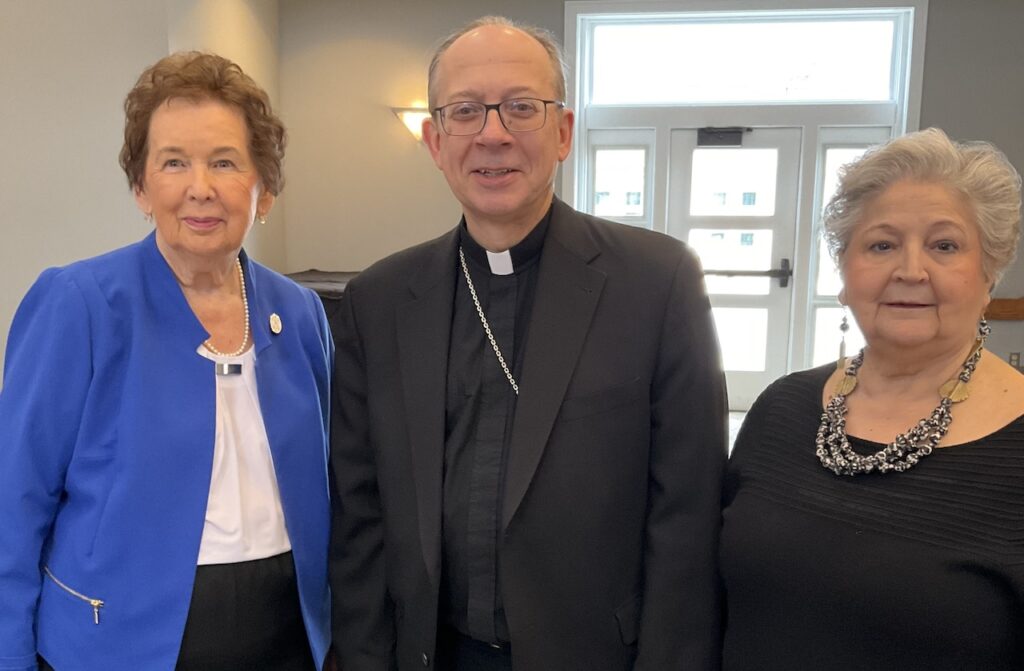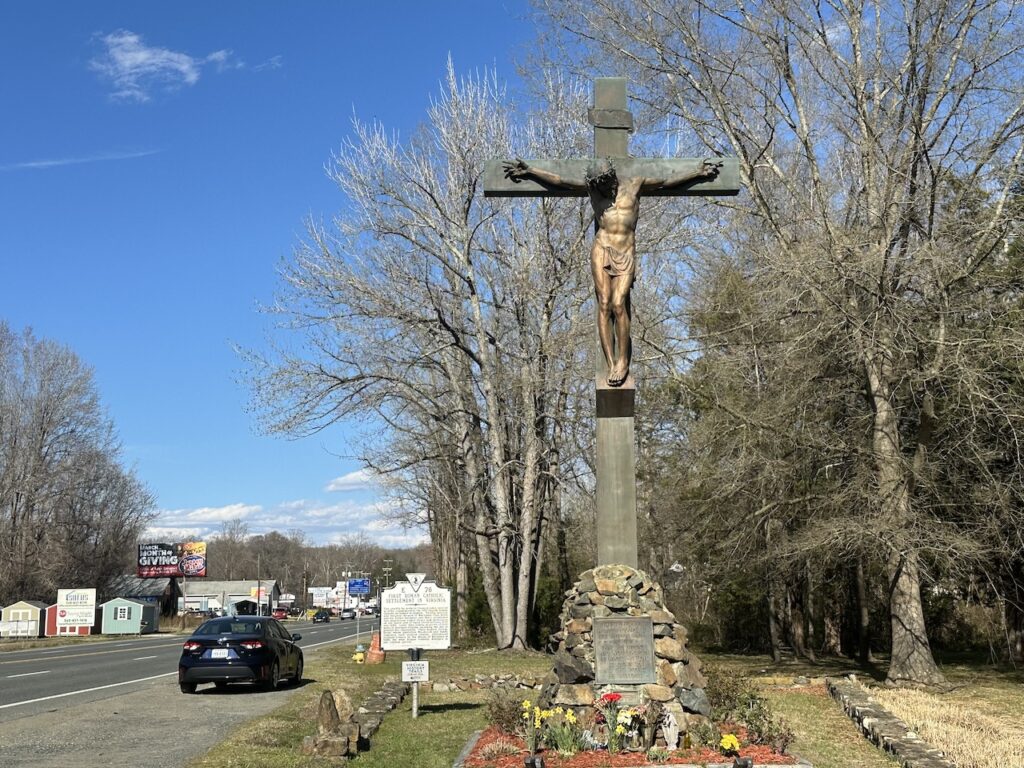There is a bronze, sculpted crucifix carrying a slightly-larger-than-life statue of Jesus found on Route 1 in Stafford County. Though crafted by artist Georg J. Lober, it was a true labor of love for members of the Catholic Woman’s Club, an organization of women who share a common faith and common goals.
Since its inception, the Catholic Woman’s Club (CWC) has worked to create lasting change throughout the state and shine a light on once-forgotten history. Bishop Barry C. Knestout celebrated the group’s 110th anniversary with a Mass on Monday, Feb. 26, at St. Michael the Archangel, Glen Allen.
In 1914, Richmond was a bustling and densely populated city, and it had the same problems as any other busy city; among them were housing, poverty and discrimination. Young women of limited means who traveled to Richmond for work needed a safe place to stay, which was in short supply at the time. Then-Bishop Denis J. O’Connell appealed to a group of local Catholic women to help these ladies find a safe place to live, and so the CWC was born.
One of their first acts was to establish Floyd Hall, a boarding house for young, working women. To live there, residents could not make more than $40 a month and were only accepted if they had a letter of recommendation from a parish pastor. A few years later, the CWC founded an orphanage, as well as a recreation camp for boys and girls.
In 1916, the CWC engaged in the women’s suffrage movement, supporting women’s right to vote. Years later, they asked the police commissioner to employ a female police officer. Soon, two female officers were hired, the first in Richmond’s history. During World War I, the CWC worked closely with the American Red Cross and the Salvation Army to respond to those in need, both locally and abroad.
Founding ladies
These ladies went on to help establish or support many organizations, such as Meals on Wheels, St. Joseph’s Villa, Comboni Missionary Sisters, and Saint Francis – Manchester. In addition, the CWC provides financial assistance to women who have been recently released from prison. The club promotes Catholic education by providing scholarships to St. Gertrude and Cristo Rey high school students in Richmond.
The CWC also worked with the Nora Houston Foundation to restore some of the artist’s work and procure a marker for her previously unmarked grave. Houston, a Richmond native, was a leading suffragette who lobbied for racial and social justice causes.
“The founding ladies seem to have been ahead of their time and were able to advance the causes near and dear to Catholicism,” said Teresita Martin, current president of the CWC. “It must have taken unique gifts to have been leaders in our community at a time when Catholics were not particularly welcomed and definitely [were] a minority.”
Many of the more than 100 members volunteer at various local organizations, such as St. Mary’s Hospital, Richmond, and Feedmore. There are also monthly gatherings, which can be for group exercise, book reviews and fundraising. All activities are rooted in faith, always beginning and ending in prayer.
Hazel Sullivan has lived everywhere from New Jersey to Hawaii, but she’s found a lasting home in Richmond with the CWC. “I like the idea of being with a group of people who all kind of have the same purpose,” she said. “It’s really important to have people of faith who are not afraid to talk about their faith.”

Preserving the legacy
One of the group’s biggest undertakings was the massive crucifix in Stafford County. This was the site of the first English Roman Catholic settlement in Virginia. In 1647, siblings Margaret, Mary, and Giles Brent moved to Virginia from Maryland to escape religious intolerance. They were granted land they originally called “Brenton,” and were given a royal mandate protecting their freedom to practice Catholicism. Over the years, the Brents acquired tens of thousands of acres that stretched to Alexandria and the Northern Neck and welcomed people of all faiths.
Margaret Brent named her stretch of land “Peace,” something she sought for herself and others. She would go on to become the first woman in the English colonies to request the right to vote; she is also known as the first female lawyer in America.
The town that eventually formed on the Brents’ land was named Aquia, and it became a prosperous port, shipping tobacco and grain all over the world. Sandstone from its quarry was mined to help build the White House and Washington Monument.
Over time, however, the town’s economy began to decline. The Brent Family Cemetery, the final resting place for five generations, became overgrown, and the story of the Brents was soon lost. Two centuries passed before Nina Archer and her husband stumbled upon the burial ground while horseback riding in 1924. The CWC, after learning more about the Brents and their influence on Catholic history, took it upon themselves to restore the cemetery.
A wall was built to protect the crumbling graves, and the group voted unanimously to erect a large crucifix on the site. Despite it being the beginning of the Great Depression, the ladies were able to raise enough money to realize this dream within a year. Donations came in from 23 U.S. states, as well as Ireland and Rome. The cross is 30 feet high, with the body of Jesus over 8 feet tall. The governor, along with 5,000 others, attended the unveiling ceremony in 1930.
A CWC pamphlet from this time stated, “Let us preserve this legacy by a monument. Let us be the Sign of the Cross, that common symbol of all Christians’ love and sacrifice.”
From 1931 to 2020, the CWC made annual pilgrimages to Aquia to celebrate Mass under the crucifix. A permanent altar was built; priests and an honor guard from the Knights of Columbus joined in the yearly procession. Annual pilgrimages are on pause due to a restoration project at the cemetery.
In 1989, developers wanted to raze the crucifix in order to build a shopping center, but the CWC fought to get both the crucifix and the cemetery recognized as national historic landmarks.
“You feel so compassionate, so calm, as if you have entered into another realm of joy,” said Mary Vial, current CWC vice president, recalling how she feels every time she visits Aquia. “You have experienced a rebirth of your faith, and a profound thankfulness to all those who are buried here, because they have brought the Catholic religion to Virginia, and to us.”
They welcome all Catholic women to join the CWC and continue their legacy.
“I pray and hope that we can continue the tradition of those wonderful women that preceded us, and that the club can grow and attract young women to carry on the vital work of sharing our faith with family and others in the community,” said Martin.
If you would like to join the Catholic Woman’s Club, please visit https://cwcrva.org/join-the-club/.

